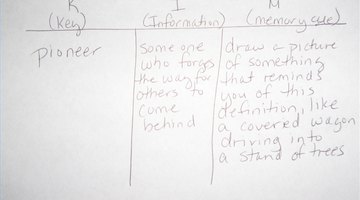Learning new vocabulary can be very difficult for some students. With a KIM chart the meanings of new words can be acquired much faster. This is a method of associating a new word with something that the student is already familiar with. It really personalizes new words so that students can remember the word meanings more readily. Requiring a KIM chart when new vocabulary and concepts are presented could easily become part of your lesson plans.
How to Use a KIM Chart For Vocabulary Study
Draw three columns of equal size on a blank sheet of paper.
Label column 1 with a K, column 2 with an I and column 3 with an M.
Write the word that you are studying in the K column. The K stands for "key." For example, if the new word that you are studying is pioneer, then you would write the word "pioneer" in the K column.
Write the user-friendly definition of the vocabulary word in column 2. The I stands for "information." In the example of "pioneer," you might write "a person who forges the way for others to come behind."
Think of a picture or memory cue that reminds you of the vocabulary word's definition. Draw or write this reminder in the M column. The M stands for "memory cue." In the above example, you would write whatever would be a personal reminder to you of this word. Drawing a picture of a covered wagon driving into a stand of trees might be something that would remind you of the word "pioneer."
Post your chart where you will see it often so that the vocabulary words can be reviewed frequently. When you see the vocabulary word, or key, visualize your memory cue, stimulating recall of the definition.
Tip
The picture or words placed in the memory cue column will be individualized for each person. Individuals will be reminded of different things when they hear or see the same word.
Tip
This can be used to learn new concepts, as well as single vocabulary words.
Related Articles
Tips
- The picture or words placed in the memory cue column will be individualized for each person. Individuals will be reminded of different things when they hear or see the same word.
- This can be used to learn new concepts, as well as single vocabulary words.
Writer Bio
Lisa Myers has been writing professionally since 1999, when her work appeared on SingleFather.org. She is an educator and she writes on various subjects but is most passionate about social and cultural concerns. Myers earned her Bachelor of Science in business management from West Virginia University Institute of Technology.










